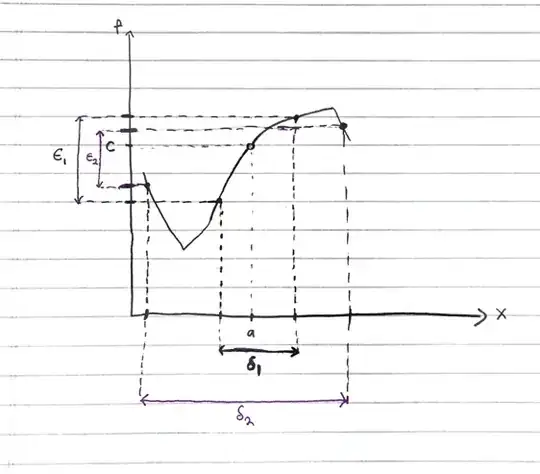Assume that the function $f$ has the following limit:
$$\lim_{x \rightarrow a} f(x) = c$$
if I have the correct understanding of what this definition should mean, the following should be true:
$$ \text{if } |x - a| \rightarrow 0 \implies | f(x) - c | \rightarrow 0$$
if this understanding is correct then using the delta-epsilon definition of a limit (as a reference here is the definition $ \forall \epsilon>0 , \exists \delta > 0, if |x -a| < \delta \implies |f(x) - c| < \epsilon $ ) then the following should be true:
if we get $x$ closer to $a$ then we should get $f(x)$ closer to $c$. i.e. $ \delta_1 < \delta_2 \implies \epsilon_1 < \epsilon_2$ in other words when getting closer by shifting to $\delta_1$ then we should get closer by some other $\epsilon_1$. In other words, if $\delta$ decreases so should $\epsilon$ (probably not visa versa since the converse of the implication of a limit means something different).
My intuition is totally convinced this should be true so I proceeded to find a proof (that I assumed was a standard real analysis exercise).
So I started by choosing two different $\epsilon_1$ and $\epsilon_2$, so $\epsilon_1 \neq \epsilon_2 $ (I started here because its first thing to fix in the quantifiers in the definition of a limit). Then by the definition of a limit they both have their own $\delta$'s call them $\delta_1, \delta_2 > 0$. It seemed reasonable to assume $\delta_1 \neq \delta_2$ because otherwise it seems that $f(x)$ wouldn't be a function (i.e. it could have one single $x$ that maps two different values of $f(x)$ in particular the values of $f(x) = c \pm \epsilon_1, c \pm \epsilon_2$ would have the same corresponding $x$ value $x = a \pm \delta_1 = a \pm \delta_2$ ). Hopefully that assumption is right. So WLOG assume $\delta_1 < \delta_2$ since the real numbers have a strict ordering. Now what I hope to show is that $\epsilon_1 < \epsilon_2$ (with not success yet). This gave me two starting facts to start the proof:
- if $ | x -a | < \delta_1 \implies | f(x) - c | < \epsilon_1$
- if $ | x -a | < \delta_2 \implies | f(x) - c | < \epsilon_2$
we know also know that:
- $ | x -a | < \delta_1 < \delta_2 \implies | f(x) - c | < \epsilon_2 $
which seemed enough to start the proof. However, as I tried to proceed I got really stuck because I thought I found a counter example to the proof I am trying to do. Let me share you the picture which I think is the counter example (which I hope is wrong somewhere):
which shows the opposite of what I expected to have. When I move from $\delta_1$ to $\delta_2$ I actually get a increase in $\epsilon$. i.e. $\epsilon_2$ is in fact smaller than $\epsilon_1$, which is opposite of what my intuition tells me. I don't know if I actually have to maybe make a further assumption in $f(x)$ to make it work (I thought maybe I needed to assume continuity but the function I drew can easily be made continuous without hurting my argument I believe). In fact as we increase $\delta$ it seems at least in this example that we can have $f(x)$ approach $c$. I am not sure what is the fault in my argument/thinking but the two things I would appreciate most in the answer are:
- Explaining why my counter argument is wrong (which I believe it is)
- providing some hints on how to actually proceed to a correct proof
- if possible even the actual proof of the statement that I am looking for (maybe the answer can be hidden so that I can give it a try first with the hints? but it would drive me crazy not to know for sure correct proof because I've embarrassingly been stuck on this for a week or two with this)
